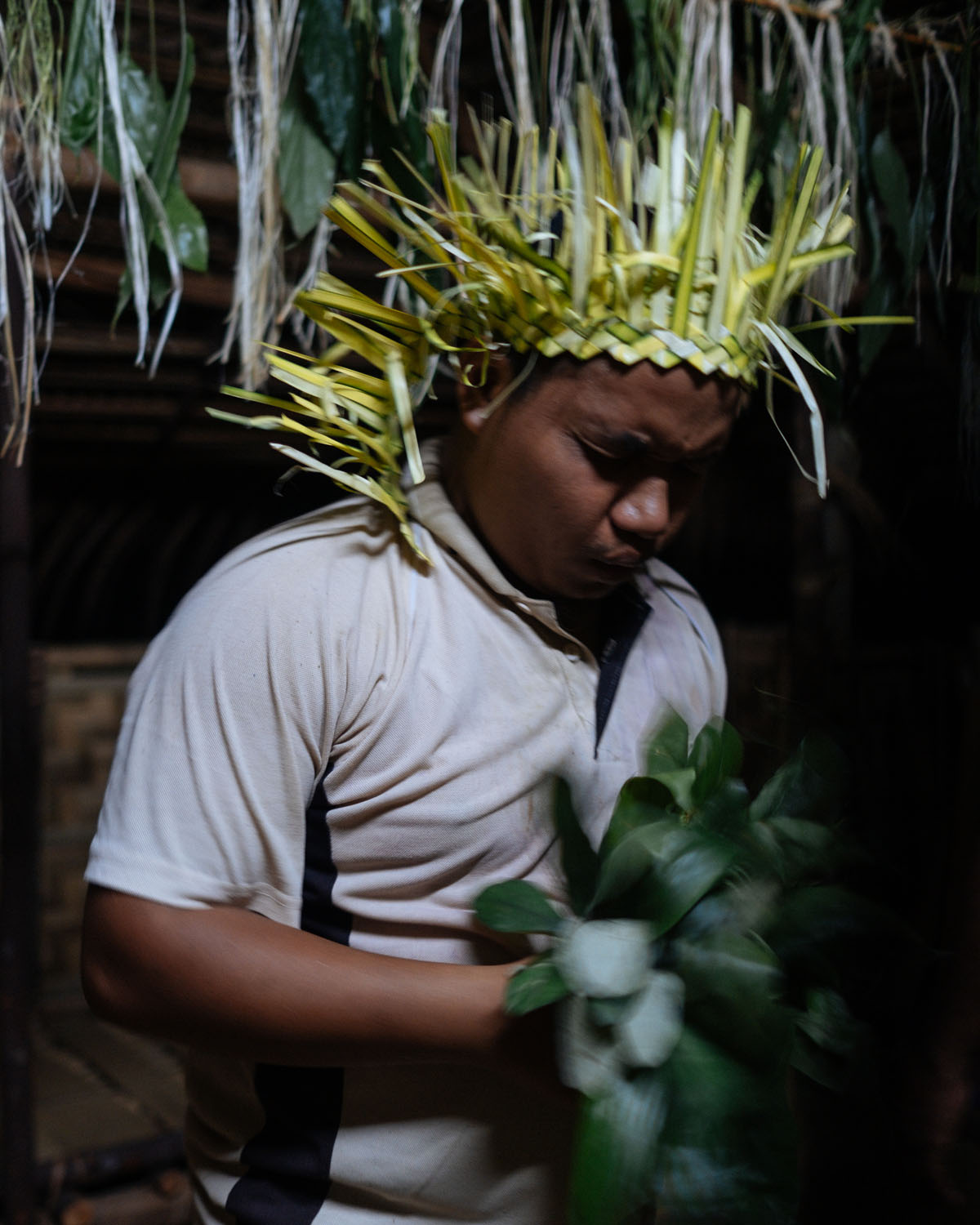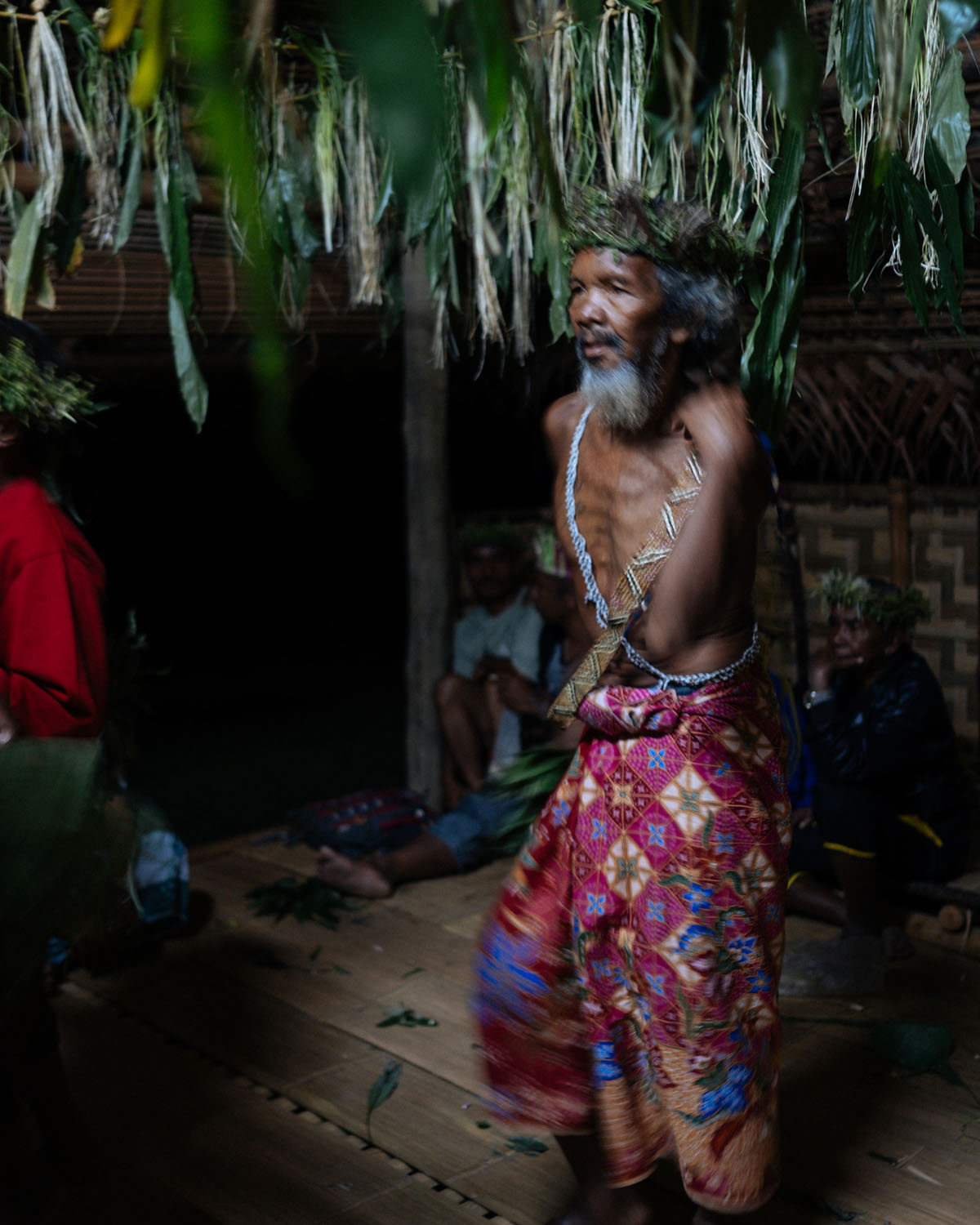1.

This time, it begins after dark. There’s a solemnity that was absent from the previous day’s rituals, which I had witnessed when the sky was still light. “This time, we have to be serious. We can’t be jokey-jokey,” says Syafiq Dendi Abdullah, a twenty-six-year-old shaman and an activist- leader of Malaysia’s indigenous Temiar community.
Amid the reverent hush of the forest in the state of Kelantan’s Gua Musang district, several men sit around a banquet of offerings: jungle produce, eggs, and mountain rice that I had seen sizzle like popcorn when cast into a hot pan. In a bowl, a root from a kasai tree burns.
The men capture the aroma in their hands and inhale deeply. Two women bend to bestow them with crowns and sashes made of delicate foliage they had huddled to braid all day. Whisks of leaves hang like streamers from the rafters, a festoon twisting down the hut’s center on a circular rattan contraption: a shimmery chandelier under the pallid fluorescent light. “Everything adds semangat and aura,” Dendi says, in a mix of Malay and English.
Then, the women start to play. Sitting in a row on one side, they stamp their bamboo tubes, softly, before building to a muscular chorus. The men rise and start to quiver, burying their faces in their leaf whisks and rustling it around their heads, heightening the symphony. They sing and bellow—“Eh paw! Woah wop!”—and dance to the varying pace and force of the stampers. The women trill back in cajoling reply.
Soon, their inner rhythm takes hold. A man drops to the ground. He shudders and writhes, upending the bamboo floorboards, scattering his leaf whisk so violently it turns into confetti. Other men embrace him as if to absorb his energy, or perhaps to steady him; they anoint him with their bouquets. Then, he stops still; the exposed soles of his feet, turned up, look strangely vulnerable.
The Temiar trace their origins back some five thousand years. “Sewang selombang is a tradition we inherited from our ancestors,” Dendi says. “When we dance, the spirits come, and they speak in their own way through each of us. We ask to be forgiven for all the harm we have done to this world.”
If the forest were to be razed, all this, and much more, would be lost.
2.

It’s the Naga, the serpent-dragon of legend, that the Temiar are appeasing through their dance. It’s said to inhabit the waterways of the forest, ready to exact penance on anyone who incurs its wrath. “Some nights ago, a headman had a dream,” says Limat Lias, a father of nine. It was time for sewang.
Traditionally animists, some Temiar have become Muslims or Christians; some have lived in urban areas. But they still follow their unwritten laws of being. Above all: Take only what you need from the forest to live, because the forest gives everything life. “Or the Bah Merah may come again,” Limat says. The “Red Flood”: a name from the old stories with apocalyptic resonance in collective memory.
It’s no idle fear: In 2014, Kelantan had its worst flood in decades, displacing more than two hundred thousand people. Some blamed the soil erosion wrought by indiscriminate deforestation. Logging has been going on for decades around here, but the total clearing of forests to make way for oil palm, rubber, or durian plantations has become more common, its effects more devastating. As one of Malaysia’s poorest states, Kelantan sells licenses for access to its forest reserves to commercial interests to shore up its coffers.
But whatever benefits are extracted, they barely flow to the Temiar. Electricity only reached them months before Malaysia’s general elections last year. Other amenities are promised in their name, but soon abandoned. You get a measure of how left behind the Temiar feel from how highly they speak of life under British rule.
“They came every week and brought food and medicine. They didn’t see us as dirty kids, and would play with us,” says Asut Uda. In the 1950s, the British were trying to win their hearts and minds, and recruited an all-indigenous covert unit to fight the communists in the jungles. It’s a history the Temiar wear proudly.
Abanj Anjang, who looks to be in his eighties (he’s lost count), says he was one of them. I met him at a blockade camp the Temiar had built to watch for loggers and plantation workers entering the area. He spends nights there. He’s still all fired up. “This land is ours! We won’t let them move anything out, not even the trees they’ve cut down!”
3.

“When I was a boy and saw loggers opening up trails in the forest, I was happy. I thought, now we can go to town and buy things,” Dendi says. In fact, many Temiar used to work in the logging industry. Who could blame them? As the modern world intruded, the Orang Asli—“original people”—had to hustle like everyone else.
It was only when they saw the polluted rivers and the dwindling fish, when they trapped fewer animals, when they had to hike farther to forage for medicinal herbs, that they realized what was at stake. “People say the Orang Asli are antidevelopment, but that is not true. We just want development that will not destroy our forest,” Dendi says. In the interior, they are free to live as they want; they can keep their children away from drugs and alcohol. “Here, there’s no hal!” Limat says, laughing. No problem: a mash-up of English and Malay.
In 2011, the Temiar built the first of many blockades to keep out loggers and plantation workers. They fought against the encroachment of their ancestral land, for which they were not given notice nor offered compensation. The blockades, rebuilt every time they were torn down, weren’t just a last resort after years of ineffectual complaints; they also demonstrated their territorial control. Eventually, the Temiar captured national headlines, and Gua Musang became synonymous with their struggle. The Malaysian government sued Kelantan for failing to uphold their rights.
The Temiar learned the law. They learned to use GPS technology to map their territorial boundaries and their cultural landmarks. They gathered a team to interview their elders and compile their oral history. Everything once taken for granted now must be proven.
And the fight goes beyond land. They’re also struggling against a history of discrimination. “On our birth certificates, we are classified as ‘Others,’ after Malays, Chinese, and Indians. Why are Orang Asli not recognized?” Dendi asks.
After the sewang that night, the men remain, shrouded in a mist of human heat. With performative seriousness, Dendi gives them news of their court case, while the men, beads of sweat still visible on their backs, listen.
This dispatch is from #VQRTrueStory, our social-media experiment in nonfiction, which you can follow by visiting us on Instagram: @vqreview.







